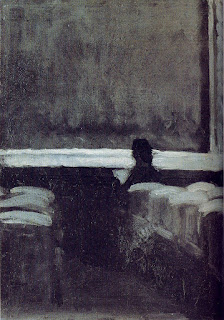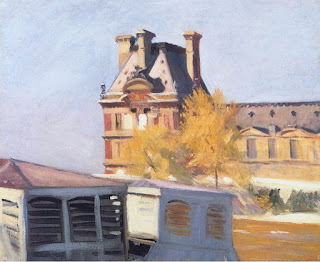Self-portrait -1905-06
" I am slightly inhuman... all I ever wanted to do was to paint sunlight on the side of a house."
Edward Hopper
Edward Hopper
An unexpected surprise and delight in Rome was coming across this exhibition of Edward Hopper's work after having visited the Colosseum, and walking up the Via Dei Fori Imperiali. I knew a lot of Hopper's famous works from the mature phase of his career, but was unfamiliar with his very early works, or many of his drawings and etchings, both of which this exhibition had plenty of. The first two paintings from early in his career below are just fantastic. The first says so much in terms of mood and atmosphere tonally, with an economy of markmaking, and the way in which the harsh light and shadow on the face of the woman are described in the second is wonderful.
Solitary Figure In A Theater - 1902-04
Woman Walking - 1906
Stairway At 48 Rue de Lille, Paris
The Railroad - 1906-07
In a Restaurant - 1916-1925
Hopper trained initially as an illustrator at the start of his career, before going on to study painting. This is very evident in the sense of narrative and theatre that his works contain. During 1906-1907 he undertook a ten month trip to Europe, where he spent most of his time in Paris. Here he admired the works of the Impressionists and in particular the work of Edgar Degas. On his return to America Hopper settled in New York, and unable to earn a living as an artist worked as an illustrator until 1925. The early works (images above), display themes which would occupy Hopper's mature works in the later stages of his career such as the alienation of figures in the city environment, atmospheric lighting in both interiors and the landscape, and the depiction of Americana.
Les Lavoirs at Pont Royal - 1907
Pavilion de Flore - 1909
Le Pont des Arts - 1907
The images created during his european journey above, were a revelation to me. You can clearly see the influence of the Impressionists in Hopper's work of this period. He admired their use of plein air painting for the light effects which could be created, and adopted this method of working when he returned to America. He also admired the French style of architecture, especially the sloping Mansard roofs which would become a regular feature in his future paintings. The influences of Degas's ballerinas, and pastels of women towelling themselves after bathing, and quite possibly Toulouse Lautrec's work, are strong in the image below, as are cinematic techniques such as the use of deep shadows, and unusual viewpoints used in film noir on his graphic work.
New York Interior - 1921
Evening Wind - 1921
Night Shadows - 1921
Hopper found it hard to sell his work on returning to America, as his style was thought of as being 'too European' and therefore very un-American. During that period there was mass migration from Europe and the migrants were regarded as bringing a lack of morals and social decline to America. Disturbing parallels with present day sentiments expressed towards Muslims and Mexicans in President Trump's America. The work below Soir Bleu, 1914 was viewed as an example of this european decadence and lack of moral character, as it depicts a prostitute touting for business. It recieved less than favourable reviews and didn't sell when exhibited, so it was stored in Hopper's studio and forgotten. It wasn't until after his death that it was discovered and put out on display again. It is now rightly viewed as an early Hopper masterpiece.
Soir Bleu, 1914
Faro A Two Lights - 1927
Hopper's drawings are very atmospheric, and composed in very similar ways to film director's storyboards. This is possibly an asset of his early training as an illustrator. They are a good display of his strong draughtsmanship, and his understanding of chiaroscuro techniques. These effects are put to good use to successfully create the sense of atmosphere and drama that pervades Hopper's paintings.
Study for the office at Night - 1940
Study for the Girlie Show - 1941
The exhibition ended with a selection of some of Hopper's more famous images which neatly sum up what his work represents - the depiction of a variety of light effects, vernacular architecture, and the sense of alienation/strange relationships between figures that populate his paintings. This exhibition was a real gem, and I was so happy to have stumbled across it.
South Carolina Morning - 1955
Cape Cod Sunset - 1934
Second Story Sunlight - 1960
"The only real influence I've ever had was myself."
Edward Hopper
Edward Hopper

























